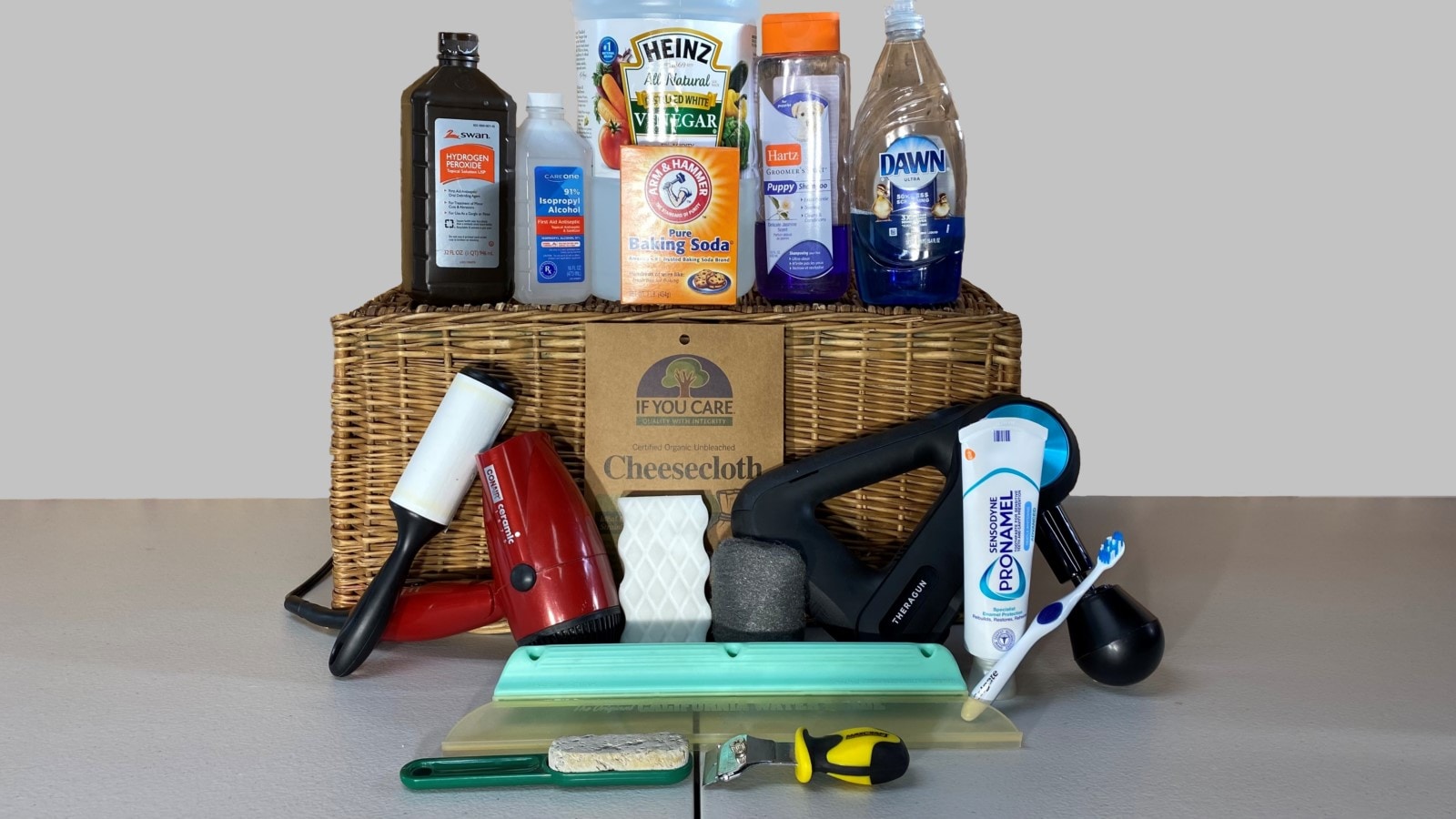
You can save time and money with DIY car cleaning hacks using products found in most households. These everyday items can help produce excellent results when you want to rejuvenate your car’s looks and smell. Check out the best car cleaning kits for auto detailing products that offer additional cleaning power.
If you’re new to car detailing, don’t have your preferred car care product, or just want to try something new, add these household items to your cleaning toolkit. With a list of 20 household products and over 40 DIY car cleaning hacks, there is no shortage of ways to clean a car’s interior and exterior finish. Always remember that a deep cleaning can improve the value of a used car by hundreds or thousands of dollars.
Cleaning Disclaimer: Always perform a test spot in an inconspicuous location when trying a new product. The surfaces of some vehicles may respond differently to a cleaning product than others, and it’s best to take precautions to avoid a costly mistake. Remember that luxury and older vehicles often have more delicate surfaces, so use extra caution cleaning those cars.
DIY Car Cleaning Hack Product List:
Toothpaste Cleaning Hacks
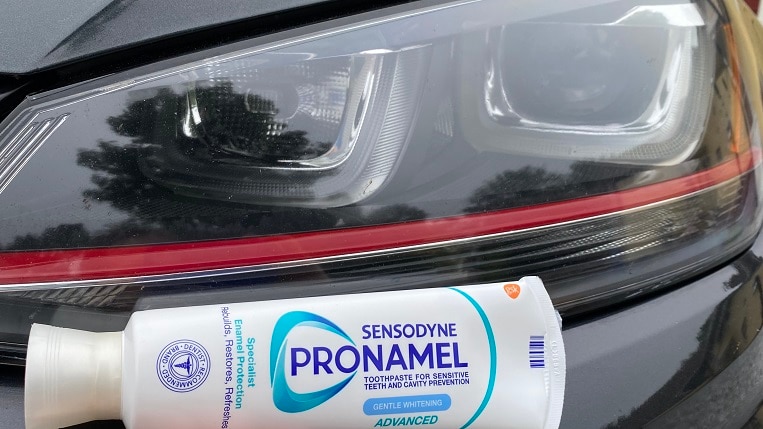
Toothpaste comes in various formulations, and those designed to whiten teeth or fight tartar buildup are also effective in some aspects of automobile cleaning. The abrasiveness of toothpaste is measured using a relative dentin abrasivity, and higher RDA toothpaste will offer better and faster results when restoring surfaces.
- Headlight restoration
- Paint scratch removal
Headlight restoration – The abrasives in toothpaste can remove light to moderate oxidation from headlight lenses. Using the most abrasive toothpaste formulation when restoring faded headlights will provide the most effective results. Apply the toothpaste to a microfiber towel and wipe the headlights in a circular motion. Using a toothbrush along with a microfiber towel increases the restoring power. Be sure to apply a layer of wax, sealant, or coating to the headlights to help prevent future UV damage.
Paint scratch removal – Toothpaste abrasiveness varies. Use light- or medium-abrasive toothpaste to remove paint scratches. Apply toothpaste to a microfiber towel and wipe the paint in a gentle circular motion. Be careful not to use too much pressure; you can easily introduce additional paint defects to the car’s paint. The only time you should wipe car paint in a circular motion is when removing scratches. Otherwise, the action may create undesirable swirl marks. Applying a layer of wax, sealant, or coating to the paint will help protect the paint from becoming contaminated.
Isopropyl Alcohol Cleaning Hacks
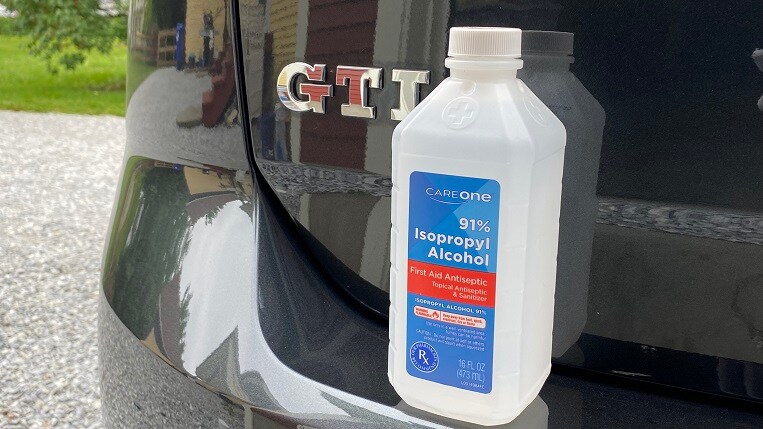
Isopropyl alcohol, or rubbing alcohol, is widely available in two concentrations — 70% and 91%. Stronger concentrations can provide up to 30% more cleaning power, which is helpful when dissolving sticker adhesive and tree sap.
- Adhesive removal
- Tree sap removal
- Ink removal
- Glass cleaning
- Wiper blade cleaning
Adhesive removal – Isopropyl alcohol can make short work of any adhesive left behind after removing a sticker or badge from a car. Using 91% alcohol will speed up the removal process and may reduce the amount of product used. Apply isopropyl to a microfiber towel and wipe the adhesive to remove it from the paint or glass.
Tree sap removal – Tree sap that has been baking in the sun for a while will be more difficult to remove than fresh tree sap. Wetting a microfiber towel with isopropyl alcohol and placing it over the tree sap will help loosen it for easier removal. Using 91% alcohol is the best choice for removing solidified tree sap from a car’s surfaces.
Ink removal – Removing pen ink from various surfaces can be achieved using isopropyl alcohol. Be careful when removing ink from a headliner, as oversaturation can cause the adhesive to become compromised and the fabric will sag. After removing ink from leather, apply a leather protectant to help shield it from future mishaps.
Glass cleaning – Diluting isopropyl alcohol with distilled or reverse-osmosis water creates an affordable and effective glass cleaner. Dilute the 91% alcohol with water at a 4-to-1 ratio and 70% alcohol with water at a 3-to-1 ratio. A window cleaner made from approximately 20% alcohol will give it plenty of cleaning power and prevent it from evaporating too quickly.
Wiper blade cleaning – Removing dirt and debris that accumulates on wiper blades can help prevent glass scratches. If the windshield wipers are chattering due to friction, the cause might be dirty wiper blades. In addition to cleaning grime from the wipers, isopropyl alcohol will help remove the outermost layer of rubber that has stiffened due to exposure to the elements.
Baking Soda Cleaning Hacks
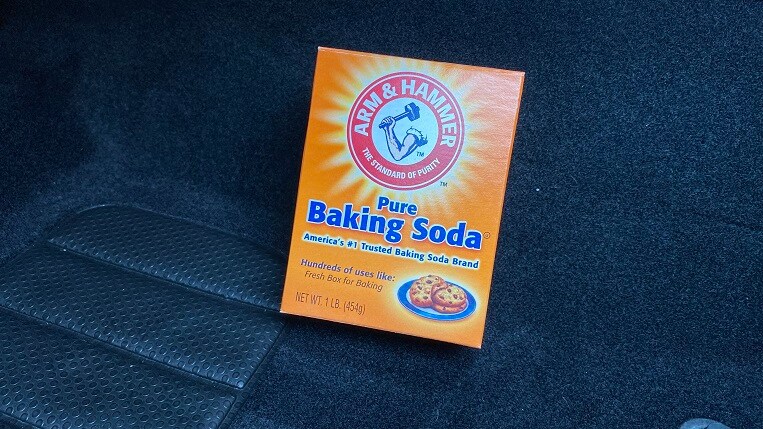
Baking soda is an effective deodorizer and stain remover that has been a household staple for generations. Some toothpaste contains baking soda because of the stain-removing powers that sodium bicarbonate provides. Combining baking soda with vinegar is a great way to supercharge your cleaning power solution, but must be used immediately due to its volatility.
- Stain removal
- Odor elimination
Stain removal – Combining baking soda with vinegar creates a powerful cleaning solution that removes various stains. Fill a spray bottle with vinegar and presoak the stain before applying baking soda. Then spray more vinegar on the stain and agitate with a nylon brush. Use the DIY hot water extractor hack to minimize the lingering odor of vinegar and achieve an even deeper clean.
Odor removal – Sprinkling baking soda directly on the carpet or cloth upholstery can help eliminate foul odors. Allow the baking soda to sit for a minimum of 15 minutes. Its cleaning power increases the longer it’s left on the surface. After waiting the desired period, remove the baking soda with a vacuum to reveal a fresher-smelling interior. You can also place the baking soda in a bowl to help eliminate less pungent odors or as part of a preventative car cleaning routine.
Dish Soap Cleaning Hacks
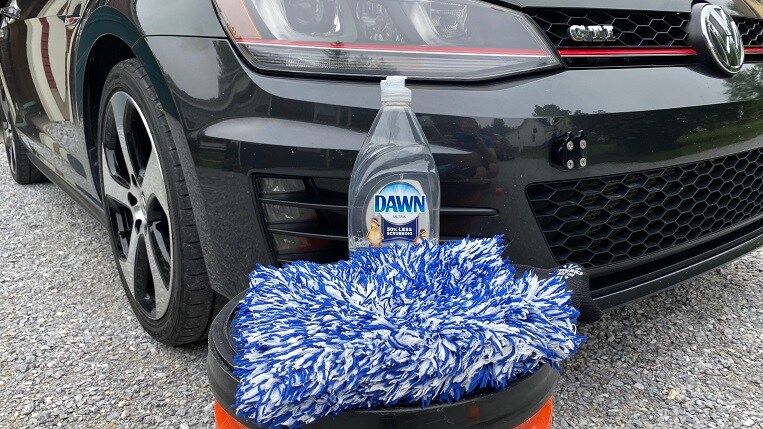
Liquid dish soap is a powerful degreaser that’s also environmentally friendly. It’s so effective at safely cleaning various surfaces that it’s used to clean animals affected by oil spills. Don’t confuse dish soap with dishwasher detergent because they have different compositions and are designed to work under different conditions. Always apply a new layer of wax or sealant to the paint, as dish soap will remove the paint’s protection along with any contamination.
- Car wash
- Bug removal
- Stain removal
Car wash – Sometimes, cars must be washed with more aggressive chemicals to remove contamination or strip off previously applied protection such as waxes and sealants. Dish soap is designed to cut through grease, which means it will remove most paint or glass protection products previously applied. Mixing 1 ounce of dish soap per gallon of water creates a powerful car wash shampoo that can remove most contamination from the paint or glass.
Bug removal – Mixing 1 ounce of dish soap per gallon of water will provide enough strength to remove a moderate accumulation of bugs. If bugs have been baking in the hot sun, consider increasing the quantity of dish soap used per gallon to 1.5–2 ounces. Soak cheesecloth in the dish soap mixture to help improve the cleaning power without damaging the paint.
Stain Removal – There’s a good chance your car’s interior was stained by food or drink. As dish soap was designed to remove food from dishes, it can do the same for your car. Add 1.5 teaspoons (0.25 ounce) per liter of water to create a gentle but effective stain remover. Use a spray bottle to apply the solution to the stain and agitate with a nylon bristle brush. Use a microfiber towel to blot the area, or try the DIY hot water extractor hack to help with drying if one is available.
Baby Soap Cleaning Hacks
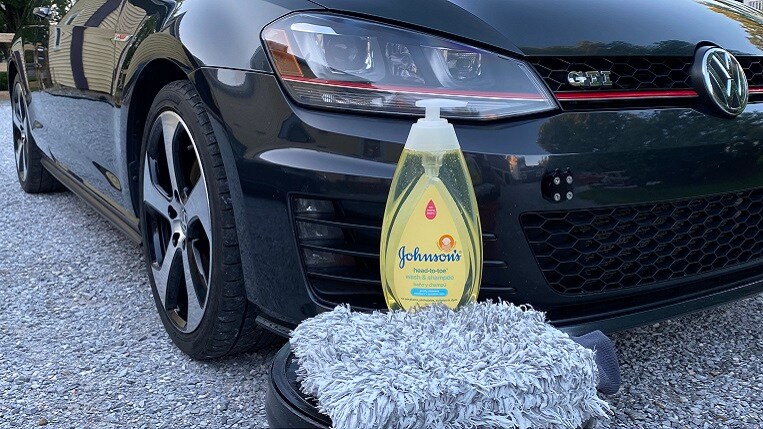
Because they’re gentler than dish soap, baby soap and pet shampoo won’t remove the products protecting the paint from damage. Baby shampoo has good lubricity and mild cleaning power, making it a good choice for washing a well-maintained car.
Car wash – Baby soap is gentler than liquid dish soap and won’t strip the paint protection if any wax or sealant is applied. Mixing 1 ounce of baby soap or pet shampoo per gallon of water produces a slippery solution that’s sometimes used to install paint protection film.
White Vinegar Cleaning Hacks
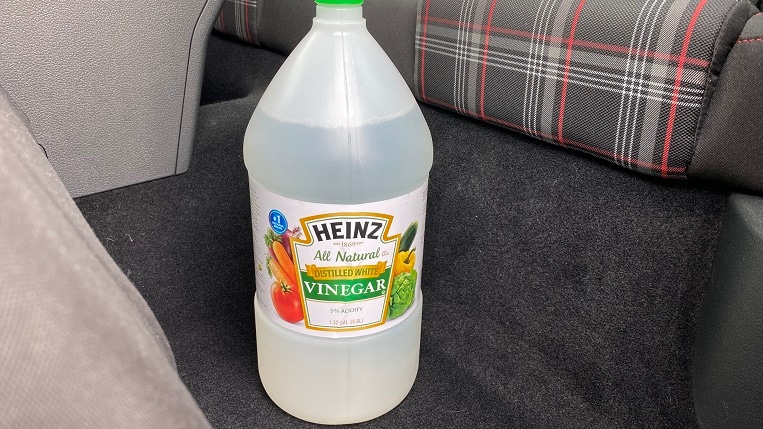
White vinegar is a highly versatile product used for various types of cleaning. Though vinegar can be used alone as an effective cleaner for most areas of a car, it can also be combined with baking soda for additional cleaning power when removing stubborn stains. Be sure to use the vinegar and baking soda solution immediately before the products can neutralize each other. Always vacuum carpet and fabric upholstery to remove loose dirt and debris before applying a stain remover.
- Stain removal
- Salt stain removal
- Water spot removal
- Glass cleaning
- Metal polishing
- Microfiber towel cleaner
Stain removal – You can remove carpet and fabric upholstery stains by mixing white vinegar with hot water at a 1-to-5 ratio. Fill a spray bottle with the vinegar solution and apply until the fabric is damp. Scrub the material using a nylon bristle brush to help remove the stain and give it a general cleaning. Tough stains may require additional vinegar applications and elbow grease when it comes time to agitate the solution. Blot the stains up using a towel, or try the DIY hot water extractor hack to suck them out of the fabric fibers and accelerate the drying time.
Salt stain removal – Salt stains on the carpet can cause permanent damage if the accumulation is severe enough. Mixing one part vinegar with five parts hot water in a spray bottle can help clean the saltiest carpets. Spray the salt stains and agitate with a nylon bristle brush after a few minutes of dwell time. Adding a few drops of essential oil or lemon juice to the vinegar mixture can help take the edge off the strong smell.
Water-spot removal – White vinegar diluted 2-to-1 with distilled or reverse osmosis water is a great way to remove hard-water spots from car paint. Fill the bucket with the vinegar solution and wash the car using a microfiber towel or wash mitt. If the water spots aren’t removed using vinegar diluted 2-to-1, it’s time to add more vinegar to the equation.
Glass cleaning – Diluting white vinegar with distilled or reverse osmosis water at a 2-to-1 ratio will create an eco-friendly and cost-effective window cleaner. Windows with water spots may need a more potent vinegar mixture and additional dwell time to clean.
Metal polishing – Mixing white vinegar with equal parts of water in a spray bottle can help clean stainless steel exhaust tips and bumpers. Spray the vinegar until the metal is wet and the microfiber towel is damp. Fine-grade steel wool can be used instead of a microfiber towel if the exhaust tips are very dirty or corroded.
Microfiber towel cleaner – Some laundry detergents have dye that can leave residue on microfiber towels and cause streaking on the car’s paint and glass. White vinegar is a great DIY laundry detergent that won’t leave behind residue on microfiber towels.
Expert tip: Wash dedicated drying towels separately from other microfiber towels used for car wax or paint sealant removal. Towels should be washed with warm water and dried on low heat. Never use fabric softener when washing or drying microfiber towels.
Melamine Sponge Cleaning Hacks
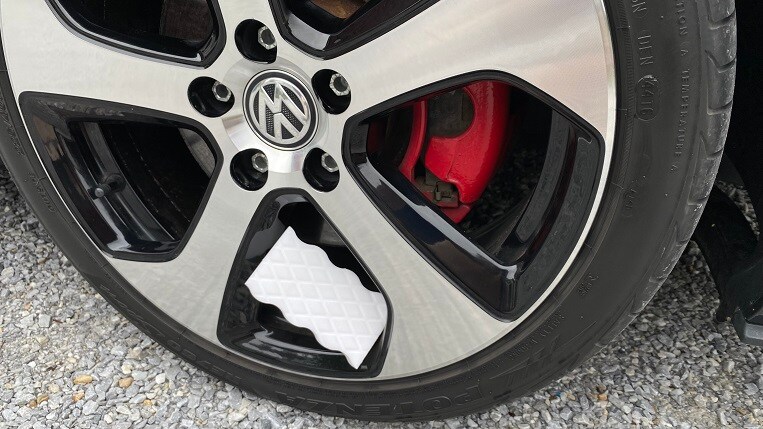
Melamine sponges, commonly known as Magic Erasers, are highly effective at cleaning and only need water to clean the dirtiest surfaces. Except for glass cleaning, you should only sparingly use melamine sponges on a vehicle’s interior and exterior surfaces. Melamine sponges are abrasive and shouldn’t be used to wash a car because they will dull the paint and require a paint correction to restore the shine.
- Ink removal
- Paint scuff removal
- Glass cleaning
- Wheel cleaning
Ink removal – Wet the melamine sponge with water and gently scrub the ink from the surface. If the ink isn’t coming off easily or the material can’t withstand further scrubbing, use isopropyl alcohol to increase the cleaning power. Be sure to reapply protectant to the leather after deep cleaning to help keep it looking great and make it easier to clean in the future.
Paint scuff removal – Paint scuffs differ from scratches because they often involve something transferred onto the paint instead of the paint itself being removed. After cleaning the paint scuff of loose contamination, use a damp melamine sponge with side-to-side movements to remove the paint scuff. If the melamine sponge doesn’t remove the abrasion, add some toothpaste to the sponge and continue scrubbing.
Glass cleaning – A microfiber towel can handle most glass cleaning jobs. However, some contamination, like dog drool, needs extra cleaning power. Cleaning glass with a damp melamine sponge will quickly and safely remove the messiest of dog-slobbered windows.
Expert Tip: Do not use a melamine sponge to clean glass with aftermarket window tint. Aftermarket window tint uses a film compared to factory window tint, which has color embedded in the glass during manufacturing.
Wheel cleaning – Strong chemicals are best for removing baked-on brake dust that has turned bronze in color. However, carefully using a melamine sponge to deep clean the stained wheels is an effective and affordable alternative. Start by cleaning the wheel faces with a damp melamine sponge before cleaning the typically much dirtier wheel barrels. Cleaning the less dirty and more delicate part of the wheel before moving on to the most-contaminated part will help minimize the risk of scratching the finish.
Shower Squeegee Cleaning Hacks
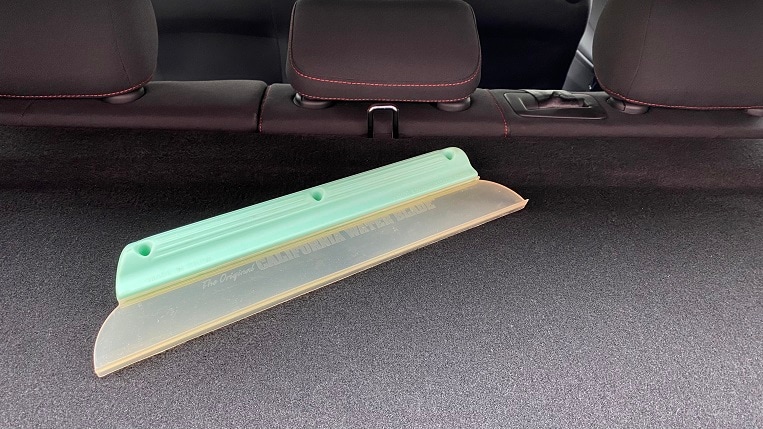
Shower squeegees are great for drying glass. They also have an unintended use: Squeegees can help remove pet hair from a car’s interior. Pulling the squeegee firmly in one direction at a time will yield the best cleaning results. After removing the loose pet hair, squeegee the carpet or upholstery fibers in the opposite direction to remove any remaining strands.
- Glass cleaning
- Pet hair removal
Glass cleaning – Using a shower squeegee to dry glass after cleaning can help save time and keep the windows streak and lint-free. Use a shower squeegee with pulling motions and slight overlap between passes. Work from the top of the glass to the bottom. After each pass, shaking excess water from the squeegee blade will yield the best results. Periodically clean the squeegee blade with a microfiber towel to ensure it is free of debris that could scratch the glass.
Pet hair removal – Shower squeegees can help clean more than just glass. Swiping a shower squeegee over carpet and fabric upholstery can remove pet hair, and it’s gentler on the surface than some of the other DIY pet hair removal techniques. Always vacuum up loose pet hair before using a shower squeegee and pull the squeegee in the same direction multiple times to remove additional hair. Alternating squeegee swipe directions will yield the best results, especially with short pet hair embedded deep into the fabric.
Hydrogen Peroxide Cleaning Hacks
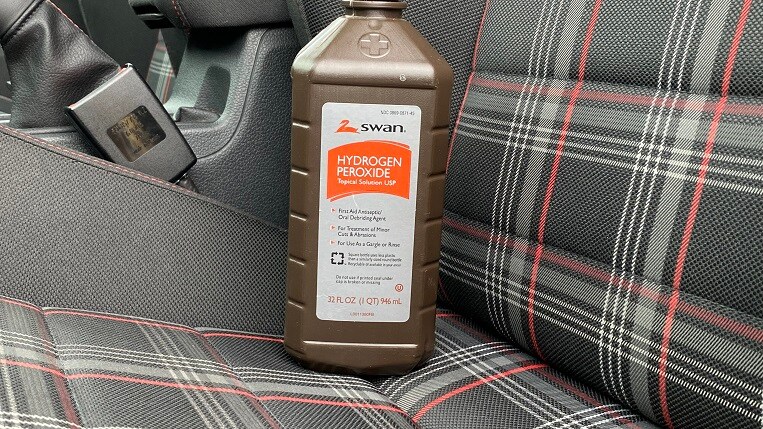
Generally, the hydrogen peroxide you buy at a pharmacy or grocery store has a 3% concentration and is ready to use. Tougher stains may require a higher concentration, but keep in mind that stronger blends of 10% or more can cause fabric bleaching. Always test the material in an inconspicuous spot to see if any such bleaching occurs.
- Stain removal
- Odor elimination
Stain removal – Hydrogen peroxide can remove many stains, but it excels at removing blood stains. Ready-to-use hydrogen peroxide bought at a store has a safe but effective 3% concentration. When removing minor stains or general cleaning, dilute hydrogen peroxide 1-to-1 with distilled water. Agitate the hydrogen peroxide with a nylon bristle brush, then blot the stains using a microfiber towel. Consider using the DIY hot water extractor hack for additional stain removal power to remove more dirt and debris from the fibers.
Odor elimination – Hydrogen peroxide will remove unsightly stains and the foul odors that often accompany them. Dilute hydrogen peroxide with distilled or reverse osmosis water at a 1-to-1 ratio to create an odor eliminator that is safe for most surfaces. Agitate the fabric using a nylon bristle brush to ensure equal coverage of all the fibers.
Steel Wool Cleaning Hacks

Steel wool is available in eight different grades:
- 4 — extra-coarse
- 3 — coarse
- 2 — medium-coarse
- 1 — medium
- 0 — medium-fine
- 00 — fine
- 000 — extra fine
- 0000 — finest
Only use 0000 steel wool when cleaning glass, or it can result in scratches that will be incredibly hard to remove. When polishing metal, start with 0000 steel wool and increase the aggressiveness. Wear gloves when using steel wool to prevent cuts and embedded metal particles.
- Glass cleaning
- Metal polishing
Glass cleaning – Generously apply glass cleaner to the windows and gently scrub them with 0000 steel wool. After cleaning the windows, dry them with a squeegee or a microfiber towel. Use isopropyl alcohol or white vinegar to make DIY glass cleaners.
Metal polishing – Apply metal polish to the stainless steel exhaust tips and rub them with 0000 steel wool. Use a coarser grade of steel wool on metal with corrosion or heavy carbon buildup. One of the best DIY metal polishing hacks combines steel wool and white vinegar, which can remove rust from metal.
Razor Blade Cleaning Hacks
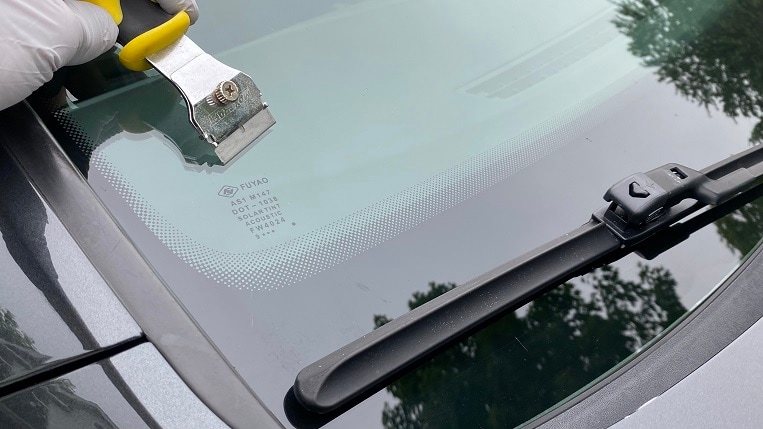
Razor blades are great at removing stubborn glass contamination, including tree sap, bug guts, and sticker adhesive. Plastic razor blades can remove adhesive from the paint without damaging it. Use razor blades at a 45-degree angle with plenty of cleaning solution and light pressure. Be sure to scrape in one direction at a time and avoid back and forth movements.
- Glass cleaning
- Adhesive removal
Glass cleaning – Glass is harder to scratch than paint and can withstand more aggressive cleaning without causing damage. A metal razor blade can safely remove stubborn contamination from glass, saving time when removing bug guts, tree sap, or paint overspray. Remove loose contamination from the glass before using the razor blade and ensure the edge stays free of debris to prevent scratches.
Adhesive removal – Depending on the surface you’re cleaning, metal or plastic razor blades will be the right choice. Only use metal razor blades to remove adhesive from glass. Use plastic razor blades to remove adhesive from paint or glass. Preheating the glue with a hair dryer before scraping it with a razor blade will make cleaning even easier.
Pumice Stone Cleaning Hacks
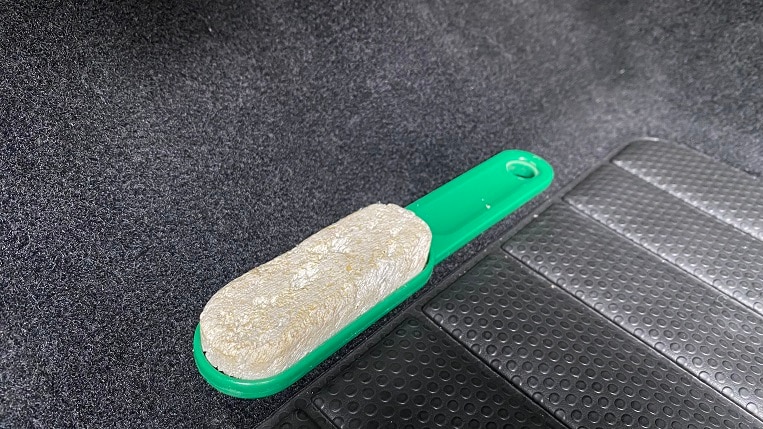
Pumice stones can help remove pet hair from carpet and fabric upholstery. Swipe the pumice stone in one direction. Then, after removing the loosened pet hair, use the pumice stone in the opposite direction to clear away any remaining hair.
Pet hair removal – Always remove as much of the loose pet hair by vacuuming before using a pumice stone. Swipe the pumice stone in one direction to dislodge embedded pet hair and vacuum the freshly loosened hair before going in the opposite direction. Using a pumice stone in multiple directions will yield the best results when removing short pet hair that weaves its way into the fabric.
Ice Cubes Cleaning Hacks
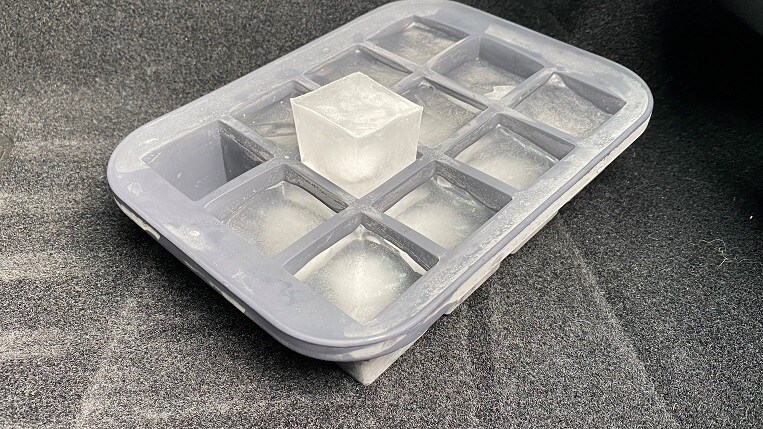
Ice cubes are an effective and low-cost way to remove gum from a car’s interior. Freezing the gum stiffens it so you can remove it in larger pieces or, if you’re lucky, in one piece. Before freezing the gum, placing the ice cubes inside a plastic bag will help prevent any potential moisture issues as they melt.
Gum removal – Removing gum from any surface of a car’s interior isn’t a good time, and removing it from fabric can be a nightmare. Removing warm gum can be futile, so it’s best to do so when the gum is cold as it will come off in larger pieces. Any remaining small pieces of gum can be scrubbed with a toothbrush and vacuumed to complete the cleaning.
Cheesecloth Cleaning Hacks
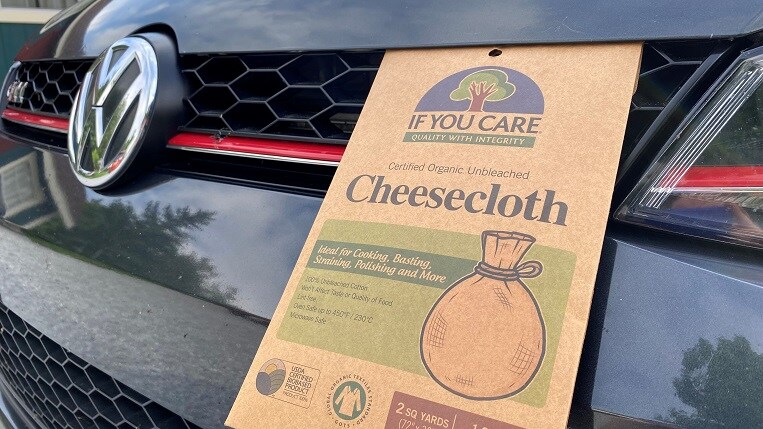
Cheesecloth has uses outside of the kitchen, too. The loosely knit cloth can remove baked bugs from the car’s bumper or mirrors, trapping them so they won’t make further contact with the paint. However, using too much pressure or excessive wiping can cause scratches. To avoid doing so, wipe only in straight line movements and never use a circular motion to prevent any swirl marks.
Bug removal – Cheesecloths are great for more than just straining cheese curds; they’re also helpful for removing baked-on bugs from a car’s exterior. After pretreating the bugs with a dish-soap mixture, remove them carefully using cheesecloth. Soak the cheesecloth in diluted dish soap and gently clean using straight-line movements with light to moderate pressure. If the bugs don’t come off easily, reapply the dish soap and allow it to soak for additional time.
Lint Roller Cleaning Hacks
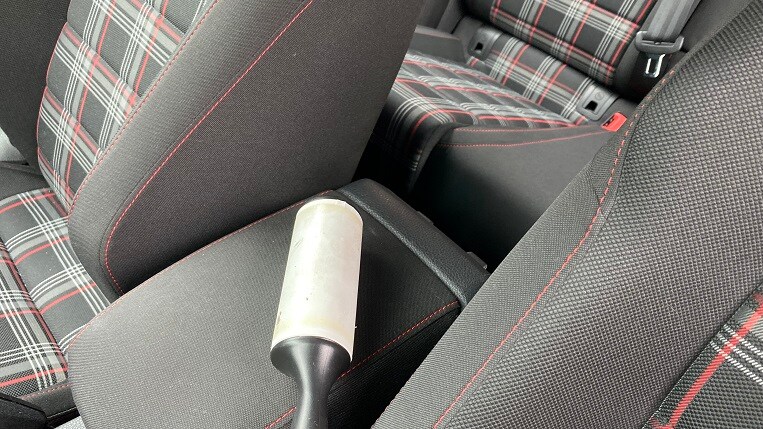
Lint rollers typically remove pet hair from clothing. You can also use them to eliminate stubborn hair from a car’s interior. In addition to removing pet hair, lint rollers also excel at cleaning the seemingly impossible-to-remove glitter.
- Pet hair removal
- Glitter removal
Pet hair removal – After removing as much loose pet hair as possible with a vacuum, a lint roller can help remove the remaining hair. Brushing the lint roller in multiple directions will help pull out the embedded pet hair from the carpet and upholstery. Short pet hairs are typically more difficult to remove since they thread themselves through the fabric.
Glitter removal – Glitter seems to stick around forever, and you may find tiny sparkles years after having it in your car. If there’s a large concentration of glitter in one area, use the vacuum nozzle before using a lint roller to remove the remaining particles.
Hair Dryer Cleaning Hacks
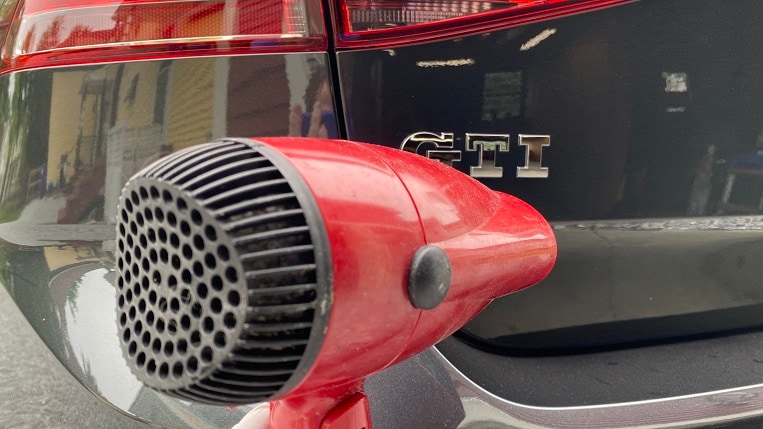
Hair dryers are a safe and readily available alternative to heat guns. While a hair dryer won’t have the same power as a heat gun, it can still generate plenty of heat to remove stickers from a car’s glass or paint. The hair dryer may take a minute to heat the adhesive compared to a few seconds with a heat gun.
Adhesive removal – Heating a sticker or badge before removing it from a car will help make the job much easier. The heat softens the adhesive, making it easier for you to remove the sticker in larger pieces and sometimes in one piece, with a bit of luck. You can then use isopropyl alcohol to remove any leftover glue left behind on the paint or glass.
Toothbrush Cleaning Hacks
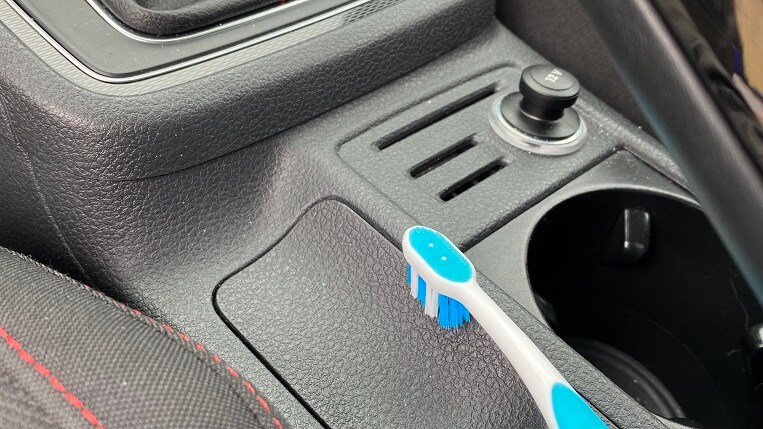
Toothbrushes are excellent at cleaning hard-to-reach areas or adding a little extra cleaning power compared to a microfiber towel. Toothbrushes are available in different types bristle stiffness (soft, medium, hard) to determine how much cleaning power the toothbrush has.
- Crevice cleaning
- Headlight restoration
Crevice cleaning – Toothbrushes clean hard-to-reach spaces, and you can use them to help clean various parts of a car’s interior and exterior. Use a soft-bristle toothbrush when cleaning delicate surfaces like paint or piano black interior trim.
Headlight restoration – Using a medium- or hard-bristle brush with toothpaste can yield quick and impressive results. Heavily oxidized and pitted lights require sanding, but a bit of elbow grease can improve headlight appearance and safety.
Massage Gun Cleaning Hacks
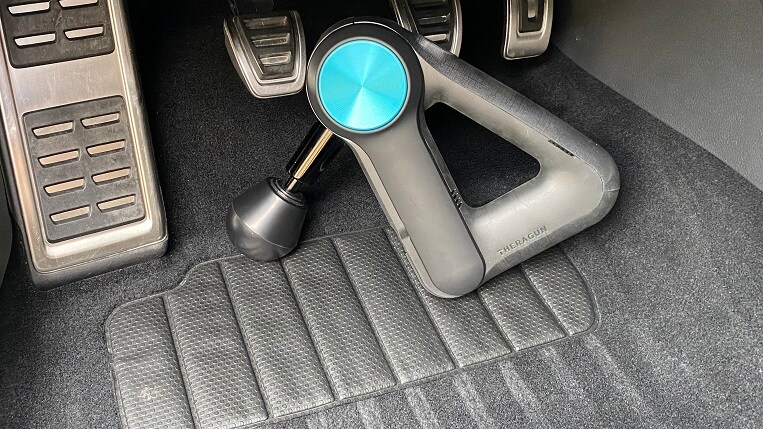
Massage guns, also known as percussive massagers, feature high-speed motors capable of more than 3,000 revolutions per minute. The high RPM of the massage gun helps bring sand to the carpet’s surface for easy vacuuming. Simultaneously operating the massage gun and vacuum will yield the best results.
Sand removal – Always use a vacuum to remove as much sand as possible before using a massage gun. Removing a large portion of the sand before agitating the carpet or fabric upholstery helps prevent sand from scattering to other interior areas.
Air Compressor Cleaning Hacks
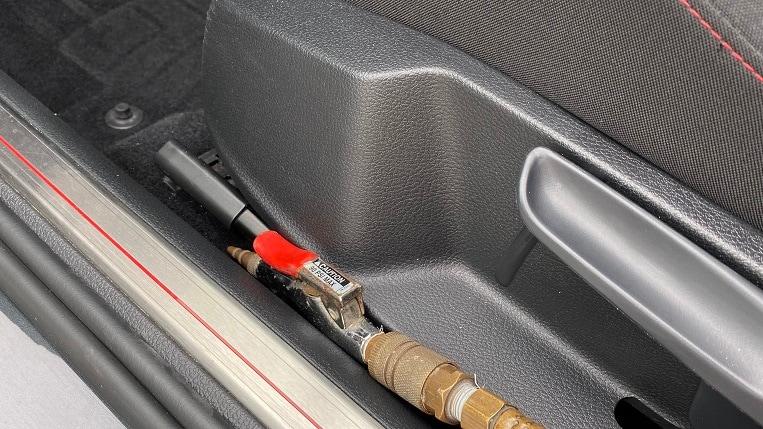
Compressed air is helpful when cleaning out tight spaces between the seats and the center console or eliminating water spots/streaks after a car wash. Whether you’re cleaning a car’s interior or exterior, there will be a few places that always seem to be out of reach of other tools.
- Crevice cleaning
- Car drying
Crevice cleaning – Cleaning between the seat rails and the center console is one of the most inaccessible spots of a car’s interior. Vacuum crevice tools help, but you’ll find some contamination requiring an air compressor to dislodge. Compressed air can dislodge and move the remaining contamination to an area the vacuum can reach.
Car drying – Avoid annoying water drips and streaks after washing a car with compressed air. Blowing water out of the grille, mirrors, door jambs, and panel gaps before drying the rest of the paint will eliminate those unsightly water drips and streaks.
Wet/Dry Vacuum Cleaning Hacks
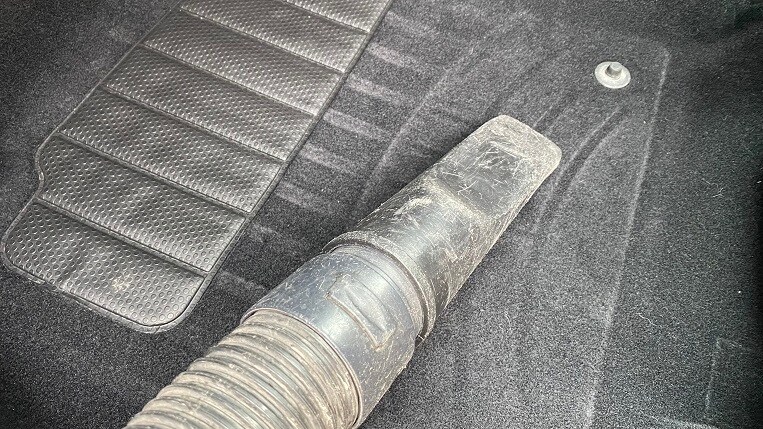
Many people have a wet and dry vacuum in their garage. Use this highly versatile piece of equipment as a DIY hot water extractor. While the household tool doesn’t match the cleaning power of a commercial-grade hot water extractor, it’s strong enough to tackle mild to moderately dirty car interiors.
Hot water extractor – While a wet and dry vacuum can’t heat and pump water into the fabric, it can suck up hot water instead. Fill a bucket with hot water and dip a nylon bristle brush into the bucket. Scrub the carpet or upholstery with a wet brush to clean the material or flush it with previously applied cleaners such as white vinegar or dish soap.
Filling a spray bottle with hot water and wetting the carpet and upholstery is another effective cleaning method. Spray the hot water onto the fabric and agitate the fibers with a nylon bristle brush before using the wet/dry vacuum.





More Stories
Glass Industry Terms – Everything You’ve Always Wanted to Know About Glass But Were Afraid to Ask
The Importance of Technical Knowledge in Modern Auto Sales Training
Everything You Need to Know About Suzuki Trucks